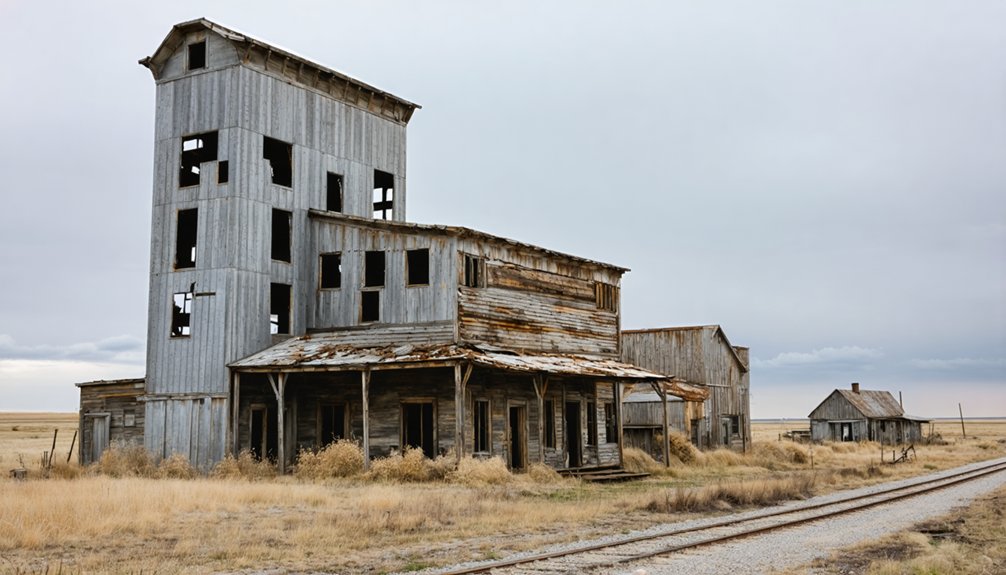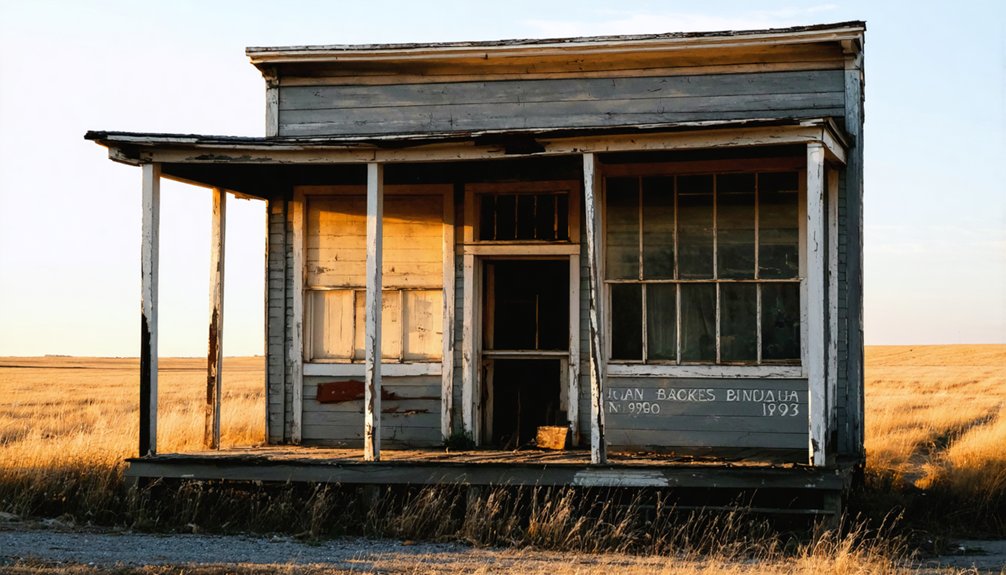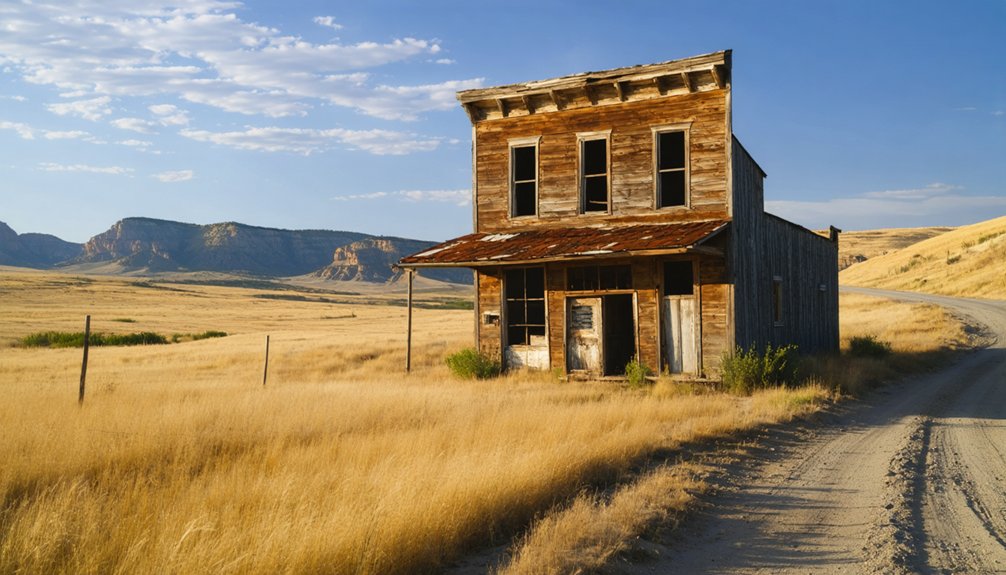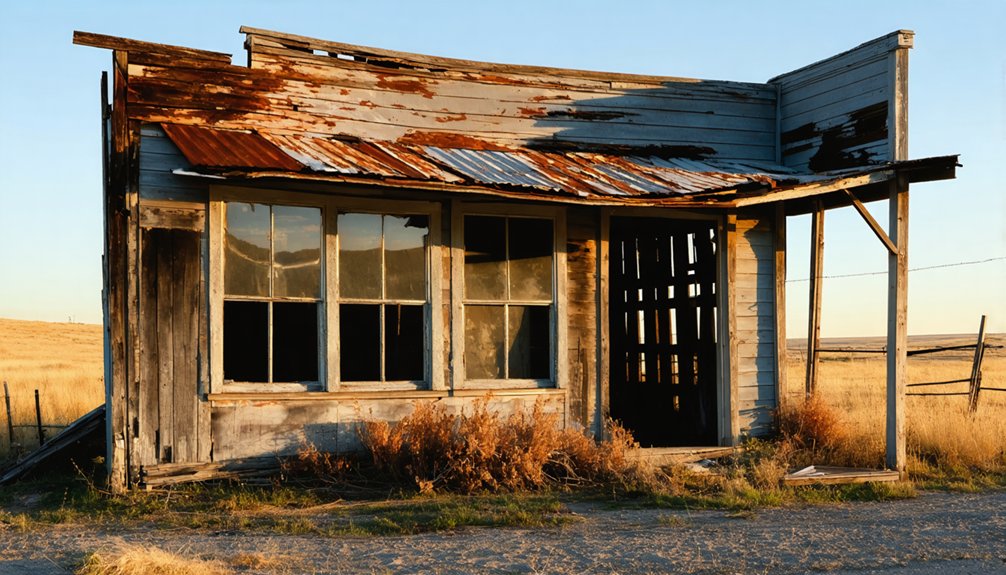You’ll find Hillhead’s ghost town remains 4 miles west of Veblen in northeastern South Dakota’s Coteau de Prairie Hills. Originally named Airmont in 1915, postal confusion forced changes to Hilltop and finally Hillhead by 1917. The railroad settlement peaked in the mid-1920s, serving local grain farmers before declining through the mid-century. By the 1970s, Hillhead had vanished, leaving just two buildings to tell its prairie settlement story.
Key Takeaways
- Established in 1915 along the Fairmont & Veblen Railroad, Hillhead was a small prairie town in northeastern South Dakota’s Coteau Hills.
- After several name changes from Airmont to Hilltop, the town settled on Hillhead in 1917 due to postal conflicts.
- The town’s economy centered on grain shipping, with essential services including a grain depot, post office, and general store.
- Population never exceeded 100 residents, and the town declined due to agricultural mechanization and changing rail service patterns.
- By the 1970s, Hillhead was abandoned, with only two buildings remaining as testament to its brief existence.
Origins and Early Settlement
As the Fairmont & Veblen Railroad expanded westward in 1915, the town of Hillhead emerged at a strategic promontory in northeastern South Dakota’s Coteau de Prairie Hills.
You’ll find this historic settlement just 4 miles west of Veblen, where early settlers capitalized on the railroad’s arrival to establish a new community.
Initially named Airmont when its post office opened in 1917, the town quickly faced naming challenges.
Due to confusion with nearby Fairmont, ND, it was renamed to Hilltop, then finally Hillhead – a name that reflected its commanding position in the landscape.
The railroad expansion proved essential for early settlers, providing crucial transportation links and spurring the town’s development. Like many South Dakota towns, Hillhead was strategically placed seven miles from neighboring stops to service steam locomotives. The community experienced rapid growth and reached its peak population mid-1920s.
The railroad’s westward push transformed frontier settlements, forging vital connections that turned isolated outposts into thriving communities.
Despite the harsh prairie winters, year-round accessibility via paved roads helped maintain connections to surrounding communities.
The Evolution of a Prairie Town Name
You’ll find the origins of Hillhead‘s name in its 1917 beginnings as Airmont, which caused postal confusion with nearby Fairmont, North Dakota.
The town’s brief stint as Hilltop proved equally problematic when officials discovered another Black Hills settlement had claimed the name.
Your modern-day ghost town finally secured its permanent identity as Hillhead in 1917, reflecting its strategic position at the head of the Coteau de Prairie Hills. The town experienced significant growth as farmers and ranchers flocked to its services between 1920 and 1927. Like many communities across the region, it required patient exploration by historians to map and document its exact location.
From Airmont to Hillhead
When settlers first established their community in northeastern South Dakota’s Coteau de Prairie Hills in 1915, they couldn’t have predicted the naming confusion that would follow.
The town’s establishment coincided with the arrival of the branch line railroad that connected Veblen to Grenville.
In 1917, they opened a post office under the name Airmont, but this created immediate postal confusion with nearby Fairmont, North Dakota, just 30 miles away.
Much like how police burgh status defined Hillhead, Scotland’s identity until 1891, you’ll find that the town’s next attempt at identity wasn’t much better – they switched to Hilltop, only to discover another Hilltop already existed in South Dakota’s Black Hills region.
Finally, they settled on Hillhead in 1917, a fitting name that reflected the town’s location at the head of the Coteau de Prairie Hills.
This name stuck, ending the brief but complex evolution of the town’s identity.
Identity Through Name Changes
The struggle to establish a permanent identity marked Hillhead’s early years as a prairie settlement, beginning with its first official designation as Airmont in 1916.
You’ll find the name significance reflected in the community’s resilience through multiple forced changes – from Airmont to Hilltop, and finally to Hillhead in 1917. Each shift brought practical challenges, disrupting mail delivery and forcing residents to adapt their business operations and daily communications.
Despite these hurdles, the town maintained its essential function as a crucial hub for local farmers and ranchers. Like many sites in various states, the buildings and infrastructure gradually deteriorated as the population dwindled.
While the naming conflicts highlighted the limited control small prairie communities had over their identities, Hillhead’s residents persevered. The final name stuck, providing the stable identity they’d sought, though it couldn’t prevent the town’s eventual decline into abandonment by the 1970s.
Geographic Naming Influences
Situated at the crest of the Coteau de Prairie Hills in northeast South Dakota, Hillhead’s name emerged from its distinct geographical positioning.
You’ll find that its identity evolved through several iterations, reflecting both topographical significance and practical needs. Initially named Airmont in 1917, the town faced confusion with nearby Fairmont, North Dakota. When officials changed it to Hilltop, they encountered another conflict with an existing Black Hills settlement.
The final name “Hillhead” perfectly captured both the town’s location and uniqueness, following prairie naming conventions while ensuring postal clarity.
This pattern of geographic-based naming wasn’t unusual – you’ll notice throughout the prairie regions that towns often adopted names reflecting their physical landscape, helping travelers and settlers easily identify locations while maintaining administrative distinction.
Life in the Coteau De Prairie Hills
Living on the windswept Coteau des Prairies demanded resilience from both Native Americans and early settlers, who adapted to its distinct environmental challenges.
You’d find yourself surrounded by a dramatic landscape rising 2,050 feet above the surrounding flatlands, where prairie ecosystems flourished despite the harsh continental climate. The flatiron-shaped plateau extends approximately 200 miles from North Dakota to South Dakota’s southern border. Today, the plateau’s reliable winds have transformed the region into a hub for wind energy development.
- You’d witness sharp-tailed grouse performing their courtship displays across expansive tallgrass prairies, while river otters played in secluded streams.
- You’d gather medicinal plants from mineral-rich fens where groundwater seeped to the surface.
- You’d seek shelter in oak and maple forests along east-facing valleys during brutal winter storms.
- You’d navigate using the plateau’s distinct shape as a landmark, just as generations before left their ghost town heritage across these hills.
Economic Activities and Challenges

Founded in 1915 alongside the Fairmont & Veblen Railroad extension, Hillhead’s economy revolved almost entirely around its rail-dependent grain shipping operations.
A small prairie town born of railroads and grain, Hillhead staked its existence on the intersection of steel and wheat.
If you’d visited during its brief heyday, you’d have found a typical small prairie rail economy – a grain depot, post office, and likely a general store serving local farmers.
The town’s fortunes were inextricably tied to the railroad’s presence. You wouldn’t have found any mining, manufacturing, or other industries to cushion against agricultural market swings. The harsh conditions of the Dirty Thirties dealt another devastating blow to the town’s sustainability.
Like many similar towns dotting South Dakota’s Coteau des Prairies region, Hillhead’s agricultural shipping focus made it vulnerable.
When rail service changes swept through the region, towns like Hillhead couldn’t adapt. Without economic diversity, even minor shifts in rail schedules or grain prices could spell disaster.
The Path to Abandonment
As harsh winters swept across the Coteau de Prairie Hills, Hillhead’s path to abandonment began with a series of compounding challenges in the early 1920s.
The causes of rural decline became increasingly apparent as the small community struggled to maintain its foothold in northeast South Dakota’s challenging landscape.
- Identity instability plagued the town through multiple name changes from Airmont to Hilltop and finally Hillhead.
- Population never exceeded 100 residents, making it difficult to sustain essential services.
- Limited economic opportunities and absence of railroad connections isolated the community.
- Agricultural mechanization reduced small farm viability, pushing residents to seek opportunities elsewhere.
Legacy and Historical Significance

When you explore Hillhead’s story, you’ll find a distinctive example of how prairie settlements in the Coteau des Prairies evolved from railroad-driven boom towns to eventual ghost towns.
The town’s agricultural heritage remains evident through its role as an essential supply hub for local farmers and ranchers between 1915 and the 1970s.
While Hillhead’s buildings have largely vanished, its cultural memory persists as a reflection of South Dakota’s rural development and the challenges that shaped small farming communities in the early 20th century.
Prairie Settlement Evolution
The legacy of Hillhead epitomizes the broader story of prairie settlement evolution throughout northeastern South Dakota in the early 20th century.
You’ll find that settlement patterns here followed a predictable trajectory, revealing how prairie demographics shifted as rural communities adapted or faded.
- Small settlements like Hillhead emerged rapidly during the 1915-1920 homesteading boom, often starting with just a post office and minimal services.
- Communities competed for survival through administrative changes, as seen in Hillhead’s name changes from Airmont to Hilltop to its final designation.
- Agricultural consolidation and mechanization in the 1930s-1950s reduced the need for numerous small trade centers.
- By the 1970s, many prairie settlements had vanished, leaving only abandoned buildings as evidence of their brief existence.
Agricultural Heritage Impact
Founded in 1915 alongside the Fairmont & Veblen Railroad, Hillhead’s agricultural heritage embodies the rise and fall of countless prairie settlements across northeastern South Dakota.
Through agricultural cooperation, the town flourished as a crucial hub where farmers accessed essential services, from grain elevators to hardware stores. You’ll find evidence of rural resilience in how the community adapted to challenges throughout the 1920s and ’30s, even as agricultural depression and drought tested their resolve.
Today, while Hillhead’s physical structures have largely vanished, its legacy lives on through Marshall County histories and visible remnants like elevator foundations.
The town’s story reflects broader patterns of agricultural change that transformed America’s northern Plains, preserved now through census records, local memories, and genealogical archives.
Ghost Town Cultural Memory
Beyond agricultural impacts, Hillhead’s cultural memory endures through shifting identities and compelling local narratives.
From its origins as Airmont in 1917 to becoming Hilltop and finally Hillhead, the town’s evolution reflects the challenges of early rural settlements.
Most intriguing are the oral traditions passed down through generations, particularly the 1930s tale of four gangsters who allegedly stashed weapons at a local farm.
- You’ll find two remaining buildings that serve as silent witnesses to the town’s past
- You can trace the town’s peak population of under 100 residents back to the mid-1920s
- You’re able to explore documents preserved in the South Dakota State Museum
- You’ll discover how local families maintain stories that connect Hillhead to the Great Depression era
Modern Day Remnants and Location

Nestled at the head of the Coteau de Prairie Hills in northeastern South Dakota, Hillhead ghost town sits approximately 4 miles west of Veblen in Marshall County.
Perched in South Dakota’s Coteau de Prairie Hills, the abandoned settlement of Hillhead stands sentinel above Marshall County’s rolling landscape.
You’ll find this remote site at coordinates 45° 50′ 6″ N, 97° 23′ 30″ W, where two remnant buildings stand as silent witnesses to a community that thrived in the early 1900s.
You can reach the ghost town year-round via paved roads, making it accessible even with a standard vehicle.
While winter brings challenging snow and cold, summer offers ideal conditions for exploring the site.
The surrounding prairie landscape stretches across the rolling hills, offering unrestricted views of the terrain that early settlers encountered.
Since becoming uninhabited in the 1970s, these remaining structures serve as the last physical traces of Hillhead’s brief but notable existence.
Frequently Asked Questions
Were There Any Notable Natural Disasters That Affected Hillhead’s Population?
You won’t find records of flooding events or drought impacts considerably affecting Hillhead’s population. The town’s decline was primarily driven by economic factors rather than natural disasters.
What Was the Peak Population of Hillhead During Its Active Years?
You’ll find that during the roaring 1920s, when Hillhead’s economy and transportation networks were at their prime, this small prairie settlement reached its zenith with fewer than 100 determined souls calling it home.
Did Any Famous Historical Figures Ever Visit or Live in Hillhead?
You won’t find any historical visitors or notable residents in the records – there’s no documentation of famous figures ever visiting or living in this small prairie settlement.
Were There Any Schools or Churches Established in Hillhead?
You won’t find documented evidence of schools or churches in Hillhead’s education history or religious significance. The town’s small population and limited surviving records don’t confirm any educational or religious establishments.
What Indigenous Tribes Originally Inhabited the Area Before Hillhead’s Establishment?
You’ll find the mighty Sioux tribes – including Dakota, Lakota, and Nakota peoples – roamed freely across this stretch of northeastern South Dakota, hunting bison and gathering plants on the Coteau des Prairies.
References
- https://www.sdpb.org/rural-life-and-history/2023-08-21/some-black-hills-ghost-towns-and-their-origins
- https://www.sdhspress.com/journal/south-dakota-history-2-2/some-black-hills-ghost-towns-and-their-origins/vol-02-no-2-some-black-hills-ghost-towns-and-their-origins.pdf
- https://core.ac.uk/download/pdf/345016075.pdf
- https://www.powderhouselodge.com/black-hills-attractions/fun-attractions/ghost-towns-of-western-south-dakota/
- https://www.youtube.com/watch?v=_0WNYsFLSLA
- https://en.wikipedia.org/wiki/List_of_ghost_towns_in_South_Dakota
- https://www.ghosttowns.com/states/sd/hillhead.html
- https://kxrb.com/not-only-is-this-a-south-dakota-ghost-town-it-had-a-heck-of-a-time-keeping-its-name/
- https://www.youtube.com/watch?v=Glucs_Rq8Xs
- https://sdgenweb.atwebpages.com/marshall/GhostTowns/hillhead.html



